An Assessment of Altman's Z-score for Bankruptcy Prediction (Germany)
VerifiedAdded on 2022/10/31
|23
|5433
|456
Report
AI Summary
This research report presents a proposal for a project investigating the efficacy of Altman's Z-score model in predicting bankruptcy, with a focus on the German economy. The study aims to replicate and assess the J-UK model developed by Almamy, Aston, and Ngwa (2016), using a longitudinal ap...
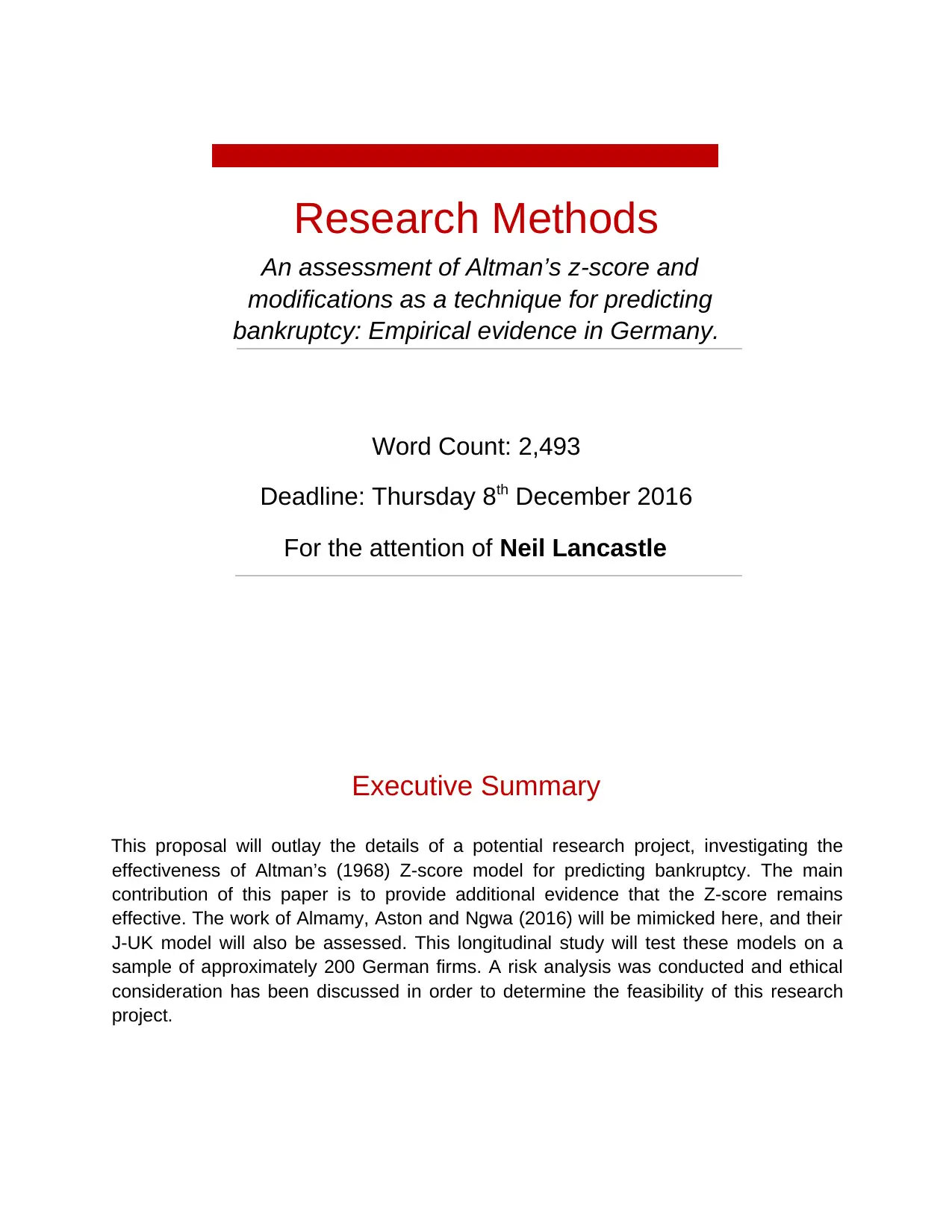
Research Methods
An assessment of Altman’s z-score and
modifications as a technique for predicting
bankruptcy: Empirical evidence in Germany.
Word Count: 2,493
Deadline: Thursday 8th December 2016
For the attention of Neil Lancastle
Executive Summary
This proposal will outlay the details of a potential research project, investigating the
effectiveness of Altman’s (1968) Z-score model for predicting bankruptcy. The main
contribution of this paper is to provide additional evidence that the Z-score remains
effective. The work of Almamy, Aston and Ngwa (2016) will be mimicked here, and their
J-UK model will also be assessed. This longitudinal study will test these models on a
sample of approximately 200 German firms. A risk analysis was conducted and ethical
consideration has been discussed in order to determine the feasibility of this research
project.
An assessment of Altman’s z-score and
modifications as a technique for predicting
bankruptcy: Empirical evidence in Germany.
Word Count: 2,493
Deadline: Thursday 8th December 2016
For the attention of Neil Lancastle
Executive Summary
This proposal will outlay the details of a potential research project, investigating the
effectiveness of Altman’s (1968) Z-score model for predicting bankruptcy. The main
contribution of this paper is to provide additional evidence that the Z-score remains
effective. The work of Almamy, Aston and Ngwa (2016) will be mimicked here, and their
J-UK model will also be assessed. This longitudinal study will test these models on a
sample of approximately 200 German firms. A risk analysis was conducted and ethical
consideration has been discussed in order to determine the feasibility of this research
project.
Paraphrase This Document
Need a fresh take? Get an instant paraphrase of this document with our AI Paraphraser

Abbreviations
Beaver (1966) A highly popular univariate method of predicting bankruptcy
using a series of financial ratios.
Bloomberg Online financial data source.
DMU De Montfort University.
EBIT Earnings Before Interest and Tax, used by Almamy, Aston and
Ngwa (2016) to establish a cash flow variable.
FMEA Failure Mode and Effects Analysis used to provide a risk
assessment for a foreseeable project.
J-UK Model A modified version of Altman’s Z-score, incorporating a cash
flow variable, established by Almamy, Aston and Ngwa (2016).
MDA Multiple Discriminant Analysis, used by Altman to develop the
first multivariate bankruptcy prediction model, namely Z-Score.
Multivariate A method using multiple factors within a model.
PRN Priority Risk Number (PRN), calculated as part of FMEA.
O-Score A popular multivariate method: Ohlson’s (1980) O-Score for
bankruptcy prediction.
Turnitin Online software used to check student’s work for plagiarism
and bad academic practice.
U.K. The United Kingdom.
U.S. United States (of America).
Univariate A method using a single factor model.
Z-Score A highly popular multivariate method: Altman’s (1968) Z-Score
for bankruptcy prediction.
Table of Contents
Introduction to the Research Topic ................................................................................. 4
Literature Review ............................................................................................................ 5
Key Theories ............................................................................................................... 5
Beaver (1966) A highly popular univariate method of predicting bankruptcy
using a series of financial ratios.
Bloomberg Online financial data source.
DMU De Montfort University.
EBIT Earnings Before Interest and Tax, used by Almamy, Aston and
Ngwa (2016) to establish a cash flow variable.
FMEA Failure Mode and Effects Analysis used to provide a risk
assessment for a foreseeable project.
J-UK Model A modified version of Altman’s Z-score, incorporating a cash
flow variable, established by Almamy, Aston and Ngwa (2016).
MDA Multiple Discriminant Analysis, used by Altman to develop the
first multivariate bankruptcy prediction model, namely Z-Score.
Multivariate A method using multiple factors within a model.
PRN Priority Risk Number (PRN), calculated as part of FMEA.
O-Score A popular multivariate method: Ohlson’s (1980) O-Score for
bankruptcy prediction.
Turnitin Online software used to check student’s work for plagiarism
and bad academic practice.
U.K. The United Kingdom.
U.S. United States (of America).
Univariate A method using a single factor model.
Z-Score A highly popular multivariate method: Altman’s (1968) Z-Score
for bankruptcy prediction.
Table of Contents
Introduction to the Research Topic ................................................................................. 4
Literature Review ............................................................................................................ 5
Key Theories ............................................................................................................... 5

Research on Bankruptcy Prediction Models ................................................................ 5
Research on Altman’s Z-Score .................................................................................... 6
Intended Contribution, Research Design & Research Questions .................................... 7
Contribution ................................................................................................................. 7
Research Design ......................................................................................................... 7
Research Questions .................................................................................................... 9
Ethical Considerations ................................................................................................... 10
Research Plan ............................................................................................................... 11
Conclusion .................................................................................................................... 12
References ............................................................................................................... 13
Bibliography ............................................................................................................. 16
Appendices ................................................................................................................... 18
Appendix 1 – German Economy ................................................................................ 18
Appendix 2 – Gantt Chart .......................................................................................... 20
Preliminary Research Plan ..................................................................................... 20
Research Plan........................................................................................................ 21
Appendix 3 – FMEA Risk Analysis............................................................................. 22
Rating Scale ........................................................................................................... 22
FMEA Analysis ....................................................................................................... 23
Research on Altman’s Z-Score .................................................................................... 6
Intended Contribution, Research Design & Research Questions .................................... 7
Contribution ................................................................................................................. 7
Research Design ......................................................................................................... 7
Research Questions .................................................................................................... 9
Ethical Considerations ................................................................................................... 10
Research Plan ............................................................................................................... 11
Conclusion .................................................................................................................... 12
References ............................................................................................................... 13
Bibliography ............................................................................................................. 16
Appendices ................................................................................................................... 18
Appendix 1 – German Economy ................................................................................ 18
Appendix 2 – Gantt Chart .......................................................................................... 20
Preliminary Research Plan ..................................................................................... 20
Research Plan........................................................................................................ 21
Appendix 3 – FMEA Risk Analysis............................................................................. 22
Rating Scale ........................................................................................................... 22
FMEA Analysis ....................................................................................................... 23
You're viewing a preview
Unlock full access by subscribing today!

Introduction to the Research Topic
When looking into the history of bankruptcy prediction models, “research up to the
mid1960’s focused on univariate (single factor/ratio) analysis. The most widely
recognised univariate study is that of Beaver [1966]” (Bellovary, Giacomino and Akers,
2007).
Moving forward in time, “univariate studies…laid the groundwork for multivariate
bankruptcy prediction models” (Bellovary, Giacomino and Akers, 2007). Altman (1968)
argued; “traditional ratio analysis is no longer an important analytical technique…due to
the relatively unsophisticated manner in which it has been presented.” The work of
Altman was the first multivariate study on bankruptcy prediction and remains
creditworthy almost fifty years later. “The Multiple Discriminant Analysis (MDA)
technique has the advantage of considering an entire profile of characteristics common
to the relevant firms, as well as the interaction of these properties” (Altman, 1968).
However, this research analysed a small, restricted sample over a short time-period; “91
manufacturing firms from the 19581961 period” (Grice and Dugan, 2001).
This research will assess the German economy as according to Bloomberg, Germany is
among the top three most innovative economies in the world (Jamriskom and Lu, 2016).
Yet since the 1970s, the number of companies going bankrupt continues to rise (see
Appendix 1). The researcher here will somewhat replicate the work of Almamy, Aston &
Ngwa (2016), assessing Altman’s Z-Score within the German economy. This will also
influence the credibility of their modified Z-score model to broader countries and add to
its generalisability within today’s globalised economy.
Literature Review
The Chartered Association of Business Schools provides an academic guide to the most
credible journals. By using the 2015 guide, filtering to the field of finance, the researcher
used journals rated three or above to ensure a high quality of literature was obtained.
The researcher then used De Montfort University’s databases only to search for
keywords to find relevant literature. Keywords included; Bankruptcy prediction; Altman’s
Z-Score; Zscore; Financial ratios; Bankruptcy models; Business failure prediction.
Key Theories
In Beaver’s study, “for every set of financial statements available, 30 ratios were
computed”, therefore this method had the ability to provide detailed analysis and
Research Proposal - Part 1
Page 4
When looking into the history of bankruptcy prediction models, “research up to the
mid1960’s focused on univariate (single factor/ratio) analysis. The most widely
recognised univariate study is that of Beaver [1966]” (Bellovary, Giacomino and Akers,
2007).
Moving forward in time, “univariate studies…laid the groundwork for multivariate
bankruptcy prediction models” (Bellovary, Giacomino and Akers, 2007). Altman (1968)
argued; “traditional ratio analysis is no longer an important analytical technique…due to
the relatively unsophisticated manner in which it has been presented.” The work of
Altman was the first multivariate study on bankruptcy prediction and remains
creditworthy almost fifty years later. “The Multiple Discriminant Analysis (MDA)
technique has the advantage of considering an entire profile of characteristics common
to the relevant firms, as well as the interaction of these properties” (Altman, 1968).
However, this research analysed a small, restricted sample over a short time-period; “91
manufacturing firms from the 19581961 period” (Grice and Dugan, 2001).
This research will assess the German economy as according to Bloomberg, Germany is
among the top three most innovative economies in the world (Jamriskom and Lu, 2016).
Yet since the 1970s, the number of companies going bankrupt continues to rise (see
Appendix 1). The researcher here will somewhat replicate the work of Almamy, Aston &
Ngwa (2016), assessing Altman’s Z-Score within the German economy. This will also
influence the credibility of their modified Z-score model to broader countries and add to
its generalisability within today’s globalised economy.
Literature Review
The Chartered Association of Business Schools provides an academic guide to the most
credible journals. By using the 2015 guide, filtering to the field of finance, the researcher
used journals rated three or above to ensure a high quality of literature was obtained.
The researcher then used De Montfort University’s databases only to search for
keywords to find relevant literature. Keywords included; Bankruptcy prediction; Altman’s
Z-Score; Zscore; Financial ratios; Bankruptcy models; Business failure prediction.
Key Theories
In Beaver’s study, “for every set of financial statements available, 30 ratios were
computed”, therefore this method had the ability to provide detailed analysis and
Research Proposal - Part 1
Page 4
Paraphrase This Document
Need a fresh take? Get an instant paraphrase of this document with our AI Paraphraser
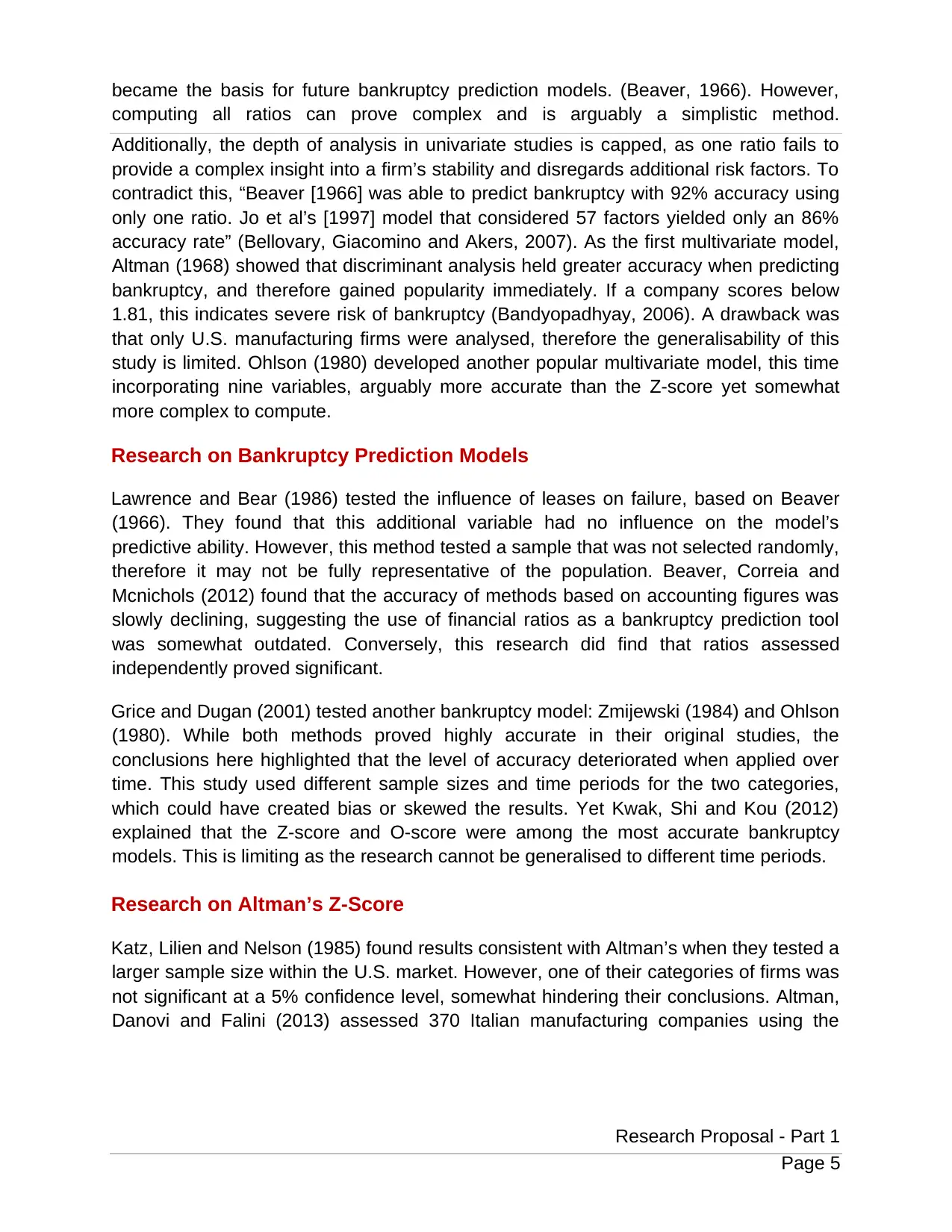
became the basis for future bankruptcy prediction models. (Beaver, 1966). However,
computing all ratios can prove complex and is arguably a simplistic method.
Additionally, the depth of analysis in univariate studies is capped, as one ratio fails to
provide a complex insight into a firm’s stability and disregards additional risk factors. To
contradict this, “Beaver [1966] was able to predict bankruptcy with 92% accuracy using
only one ratio. Jo et al’s [1997] model that considered 57 factors yielded only an 86%
accuracy rate” (Bellovary, Giacomino and Akers, 2007). As the first multivariate model,
Altman (1968) showed that discriminant analysis held greater accuracy when predicting
bankruptcy, and therefore gained popularity immediately. If a company scores below
1.81, this indicates severe risk of bankruptcy (Bandyopadhyay, 2006). A drawback was
that only U.S. manufacturing firms were analysed, therefore the generalisability of this
study is limited. Ohlson (1980) developed another popular multivariate model, this time
incorporating nine variables, arguably more accurate than the Z-score yet somewhat
more complex to compute.
Research on Bankruptcy Prediction Models
Lawrence and Bear (1986) tested the influence of leases on failure, based on Beaver
(1966). They found that this additional variable had no influence on the model’s
predictive ability. However, this method tested a sample that was not selected randomly,
therefore it may not be fully representative of the population. Beaver, Correia and
Mcnichols (2012) found that the accuracy of methods based on accounting figures was
slowly declining, suggesting the use of financial ratios as a bankruptcy prediction tool
was somewhat outdated. Conversely, this research did find that ratios assessed
independently proved significant.
Grice and Dugan (2001) tested another bankruptcy model: Zmijewski (1984) and Ohlson
(1980). While both methods proved highly accurate in their original studies, the
conclusions here highlighted that the level of accuracy deteriorated when applied over
time. This study used different sample sizes and time periods for the two categories,
which could have created bias or skewed the results. Yet Kwak, Shi and Kou (2012)
explained that the Z-score and O-score were among the most accurate bankruptcy
models. This is limiting as the research cannot be generalised to different time periods.
Research on Altman’s Z-Score
Katz, Lilien and Nelson (1985) found results consistent with Altman’s when they tested a
larger sample size within the U.S. market. However, one of their categories of firms was
not significant at a 5% confidence level, somewhat hindering their conclusions. Altman,
Danovi and Falini (2013) assessed 370 Italian manufacturing companies using the
Research Proposal - Part 1
Page 5
computing all ratios can prove complex and is arguably a simplistic method.
Additionally, the depth of analysis in univariate studies is capped, as one ratio fails to
provide a complex insight into a firm’s stability and disregards additional risk factors. To
contradict this, “Beaver [1966] was able to predict bankruptcy with 92% accuracy using
only one ratio. Jo et al’s [1997] model that considered 57 factors yielded only an 86%
accuracy rate” (Bellovary, Giacomino and Akers, 2007). As the first multivariate model,
Altman (1968) showed that discriminant analysis held greater accuracy when predicting
bankruptcy, and therefore gained popularity immediately. If a company scores below
1.81, this indicates severe risk of bankruptcy (Bandyopadhyay, 2006). A drawback was
that only U.S. manufacturing firms were analysed, therefore the generalisability of this
study is limited. Ohlson (1980) developed another popular multivariate model, this time
incorporating nine variables, arguably more accurate than the Z-score yet somewhat
more complex to compute.
Research on Bankruptcy Prediction Models
Lawrence and Bear (1986) tested the influence of leases on failure, based on Beaver
(1966). They found that this additional variable had no influence on the model’s
predictive ability. However, this method tested a sample that was not selected randomly,
therefore it may not be fully representative of the population. Beaver, Correia and
Mcnichols (2012) found that the accuracy of methods based on accounting figures was
slowly declining, suggesting the use of financial ratios as a bankruptcy prediction tool
was somewhat outdated. Conversely, this research did find that ratios assessed
independently proved significant.
Grice and Dugan (2001) tested another bankruptcy model: Zmijewski (1984) and Ohlson
(1980). While both methods proved highly accurate in their original studies, the
conclusions here highlighted that the level of accuracy deteriorated when applied over
time. This study used different sample sizes and time periods for the two categories,
which could have created bias or skewed the results. Yet Kwak, Shi and Kou (2012)
explained that the Z-score and O-score were among the most accurate bankruptcy
models. This is limiting as the research cannot be generalised to different time periods.
Research on Altman’s Z-Score
Katz, Lilien and Nelson (1985) found results consistent with Altman’s when they tested a
larger sample size within the U.S. market. However, one of their categories of firms was
not significant at a 5% confidence level, somewhat hindering their conclusions. Altman,
Danovi and Falini (2013) assessed 370 Italian manufacturing companies using the
Research Proposal - Part 1
Page 5
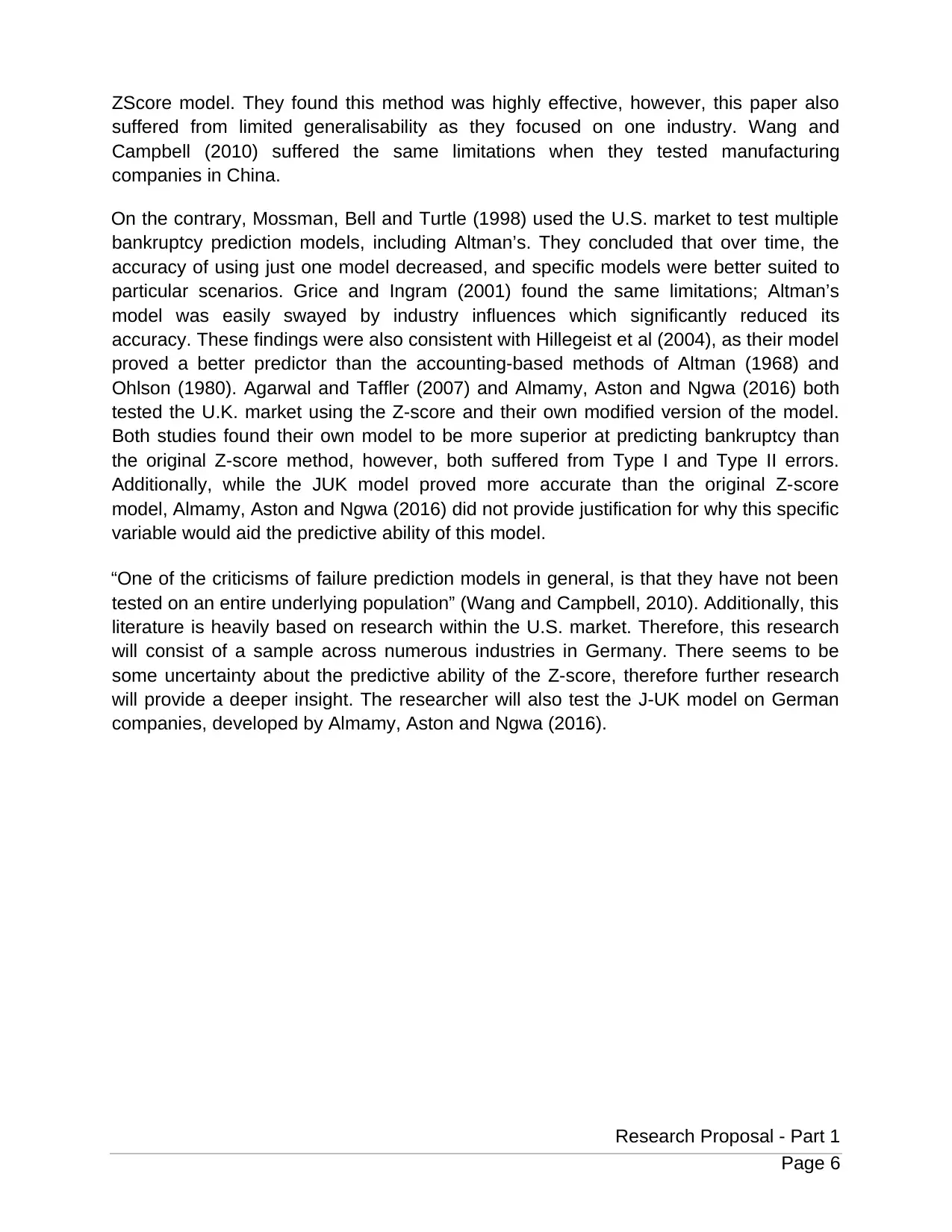
ZScore model. They found this method was highly effective, however, this paper also
suffered from limited generalisability as they focused on one industry. Wang and
Campbell (2010) suffered the same limitations when they tested manufacturing
companies in China.
On the contrary, Mossman, Bell and Turtle (1998) used the U.S. market to test multiple
bankruptcy prediction models, including Altman’s. They concluded that over time, the
accuracy of using just one model decreased, and specific models were better suited to
particular scenarios. Grice and Ingram (2001) found the same limitations; Altman’s
model was easily swayed by industry influences which significantly reduced its
accuracy. These findings were also consistent with Hillegeist et al (2004), as their model
proved a better predictor than the accounting-based methods of Altman (1968) and
Ohlson (1980). Agarwal and Taffler (2007) and Almamy, Aston and Ngwa (2016) both
tested the U.K. market using the Z-score and their own modified version of the model.
Both studies found their own model to be more superior at predicting bankruptcy than
the original Z-score method, however, both suffered from Type I and Type II errors.
Additionally, while the JUK model proved more accurate than the original Z-score
model, Almamy, Aston and Ngwa (2016) did not provide justification for why this specific
variable would aid the predictive ability of this model.
“One of the criticisms of failure prediction models in general, is that they have not been
tested on an entire underlying population” (Wang and Campbell, 2010). Additionally, this
literature is heavily based on research within the U.S. market. Therefore, this research
will consist of a sample across numerous industries in Germany. There seems to be
some uncertainty about the predictive ability of the Z-score, therefore further research
will provide a deeper insight. The researcher will also test the J-UK model on German
companies, developed by Almamy, Aston and Ngwa (2016).
Research Proposal - Part 1
Page 6
suffered from limited generalisability as they focused on one industry. Wang and
Campbell (2010) suffered the same limitations when they tested manufacturing
companies in China.
On the contrary, Mossman, Bell and Turtle (1998) used the U.S. market to test multiple
bankruptcy prediction models, including Altman’s. They concluded that over time, the
accuracy of using just one model decreased, and specific models were better suited to
particular scenarios. Grice and Ingram (2001) found the same limitations; Altman’s
model was easily swayed by industry influences which significantly reduced its
accuracy. These findings were also consistent with Hillegeist et al (2004), as their model
proved a better predictor than the accounting-based methods of Altman (1968) and
Ohlson (1980). Agarwal and Taffler (2007) and Almamy, Aston and Ngwa (2016) both
tested the U.K. market using the Z-score and their own modified version of the model.
Both studies found their own model to be more superior at predicting bankruptcy than
the original Z-score method, however, both suffered from Type I and Type II errors.
Additionally, while the JUK model proved more accurate than the original Z-score
model, Almamy, Aston and Ngwa (2016) did not provide justification for why this specific
variable would aid the predictive ability of this model.
“One of the criticisms of failure prediction models in general, is that they have not been
tested on an entire underlying population” (Wang and Campbell, 2010). Additionally, this
literature is heavily based on research within the U.S. market. Therefore, this research
will consist of a sample across numerous industries in Germany. There seems to be
some uncertainty about the predictive ability of the Z-score, therefore further research
will provide a deeper insight. The researcher will also test the J-UK model on German
companies, developed by Almamy, Aston and Ngwa (2016).
Research Proposal - Part 1
Page 6
You're viewing a preview
Unlock full access by subscribing today!
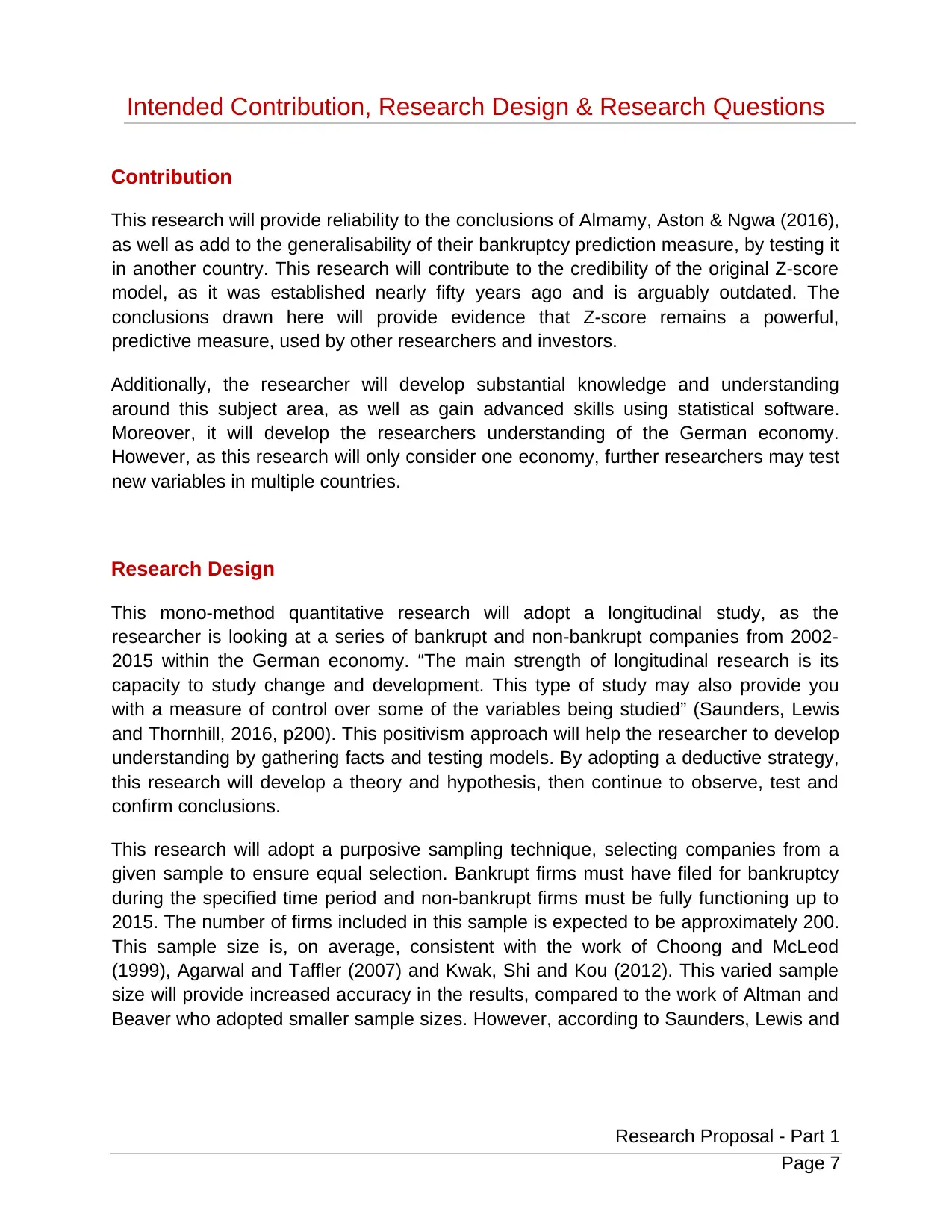
Intended Contribution, Research Design & Research Questions
Contribution
This research will provide reliability to the conclusions of Almamy, Aston & Ngwa (2016),
as well as add to the generalisability of their bankruptcy prediction measure, by testing it
in another country. This research will contribute to the credibility of the original Z-score
model, as it was established nearly fifty years ago and is arguably outdated. The
conclusions drawn here will provide evidence that Z-score remains a powerful,
predictive measure, used by other researchers and investors.
Additionally, the researcher will develop substantial knowledge and understanding
around this subject area, as well as gain advanced skills using statistical software.
Moreover, it will develop the researchers understanding of the German economy.
However, as this research will only consider one economy, further researchers may test
new variables in multiple countries.
Research Design
This mono-method quantitative research will adopt a longitudinal study, as the
researcher is looking at a series of bankrupt and non-bankrupt companies from 2002-
2015 within the German economy. “The main strength of longitudinal research is its
capacity to study change and development. This type of study may also provide you
with a measure of control over some of the variables being studied” (Saunders, Lewis
and Thornhill, 2016, p200). This positivism approach will help the researcher to develop
understanding by gathering facts and testing models. By adopting a deductive strategy,
this research will develop a theory and hypothesis, then continue to observe, test and
confirm conclusions.
This research will adopt a purposive sampling technique, selecting companies from a
given sample to ensure equal selection. Bankrupt firms must have filed for bankruptcy
during the specified time period and non-bankrupt firms must be fully functioning up to
2015. The number of firms included in this sample is expected to be approximately 200.
This sample size is, on average, consistent with the work of Choong and McLeod
(1999), Agarwal and Taffler (2007) and Kwak, Shi and Kou (2012). This varied sample
size will provide increased accuracy in the results, compared to the work of Altman and
Beaver who adopted smaller sample sizes. However, according to Saunders, Lewis and
Research Proposal - Part 1
Page 7
Contribution
This research will provide reliability to the conclusions of Almamy, Aston & Ngwa (2016),
as well as add to the generalisability of their bankruptcy prediction measure, by testing it
in another country. This research will contribute to the credibility of the original Z-score
model, as it was established nearly fifty years ago and is arguably outdated. The
conclusions drawn here will provide evidence that Z-score remains a powerful,
predictive measure, used by other researchers and investors.
Additionally, the researcher will develop substantial knowledge and understanding
around this subject area, as well as gain advanced skills using statistical software.
Moreover, it will develop the researchers understanding of the German economy.
However, as this research will only consider one economy, further researchers may test
new variables in multiple countries.
Research Design
This mono-method quantitative research will adopt a longitudinal study, as the
researcher is looking at a series of bankrupt and non-bankrupt companies from 2002-
2015 within the German economy. “The main strength of longitudinal research is its
capacity to study change and development. This type of study may also provide you
with a measure of control over some of the variables being studied” (Saunders, Lewis
and Thornhill, 2016, p200). This positivism approach will help the researcher to develop
understanding by gathering facts and testing models. By adopting a deductive strategy,
this research will develop a theory and hypothesis, then continue to observe, test and
confirm conclusions.
This research will adopt a purposive sampling technique, selecting companies from a
given sample to ensure equal selection. Bankrupt firms must have filed for bankruptcy
during the specified time period and non-bankrupt firms must be fully functioning up to
2015. The number of firms included in this sample is expected to be approximately 200.
This sample size is, on average, consistent with the work of Choong and McLeod
(1999), Agarwal and Taffler (2007) and Kwak, Shi and Kou (2012). This varied sample
size will provide increased accuracy in the results, compared to the work of Altman and
Beaver who adopted smaller sample sizes. However, according to Saunders, Lewis and
Research Proposal - Part 1
Page 7
Paraphrase This Document
Need a fresh take? Get an instant paraphrase of this document with our AI Paraphraser

Thornhill (2016, p298), using a purposive sample has a low likelihood of being
representative.
Further details will be provided in the methodology section.
This secondary data will be obtained from Bloomberg, which is a trusted source and
easily accessible, used by previous researchers such as Almamy, Aston and Ngwa
(2016). However, there is a wealth of data which can be complex to filter and different
databases may have different data collection methods, which could mean the results
may differ depending on the database used.
In order for this research to maintain reliability and replicability, it must provide thorough
testing to produce robust results. Therefore, the researcher should provide enough
details so that if this research is repeated, it is replicated accurately so the same results
can be found. To ensure ecological validity, the researcher has identified a lack of
research conducted within the German economy, therefore this project will provide
relevance and contribution to its field. In light of this, external validity may be limited as
the generalizability of the results produced may only be applicable to one country.
Research Proposal - Part 1
Page 8
representative.
Further details will be provided in the methodology section.
This secondary data will be obtained from Bloomberg, which is a trusted source and
easily accessible, used by previous researchers such as Almamy, Aston and Ngwa
(2016). However, there is a wealth of data which can be complex to filter and different
databases may have different data collection methods, which could mean the results
may differ depending on the database used.
In order for this research to maintain reliability and replicability, it must provide thorough
testing to produce robust results. Therefore, the researcher should provide enough
details so that if this research is repeated, it is replicated accurately so the same results
can be found. To ensure ecological validity, the researcher has identified a lack of
research conducted within the German economy, therefore this project will provide
relevance and contribution to its field. In light of this, external validity may be limited as
the generalizability of the results produced may only be applicable to one country.
Research Proposal - Part 1
Page 8

Research Questions
H0: There is no predictive ability in the variables in the Z-score model within the German
economy.
H1: There is predictive ability in the variables in the Z-score model within the German
economy.
H0: There is no difference between adding a cash flow variable and the predictability of
the original Z-score model within the German economy.
H2: There is a difference between adding a cash flow variable and the predictability of
the original Z-score model within the German economy.
H0: There is no difference between removing the EBIT/Total Assets variable* from the
original Z-score model and the predictive ability of the model.
H3: There is a difference between removing the EBIT/Total Assets variable* from the
original Z-score model and the predictive ability of the model.
H0: There is no difference between removing the EBIT/Total Assets variable* from the
modified J-UK model and its predictive ability.
H4: There is a difference between removing the EBIT/Total Assets variable* from the
modified J-UK model and its predictive ability.
*Almamy, Aston and Ngwa (2016) introduced a cash flow variable and after results
showed the Earnings Before Interest and Tax (EBIT) divided by Total Assets variable
was insignificance, this provides grounds to omit this variable from the model and test if
there is any significant difference in its predictive abilities.
Research Proposal - Part 1
Page 9
H0: There is no predictive ability in the variables in the Z-score model within the German
economy.
H1: There is predictive ability in the variables in the Z-score model within the German
economy.
H0: There is no difference between adding a cash flow variable and the predictability of
the original Z-score model within the German economy.
H2: There is a difference between adding a cash flow variable and the predictability of
the original Z-score model within the German economy.
H0: There is no difference between removing the EBIT/Total Assets variable* from the
original Z-score model and the predictive ability of the model.
H3: There is a difference between removing the EBIT/Total Assets variable* from the
original Z-score model and the predictive ability of the model.
H0: There is no difference between removing the EBIT/Total Assets variable* from the
modified J-UK model and its predictive ability.
H4: There is a difference between removing the EBIT/Total Assets variable* from the
modified J-UK model and its predictive ability.
*Almamy, Aston and Ngwa (2016) introduced a cash flow variable and after results
showed the Earnings Before Interest and Tax (EBIT) divided by Total Assets variable
was insignificance, this provides grounds to omit this variable from the model and test if
there is any significant difference in its predictive abilities.
Research Proposal - Part 1
Page 9
You're viewing a preview
Unlock full access by subscribing today!
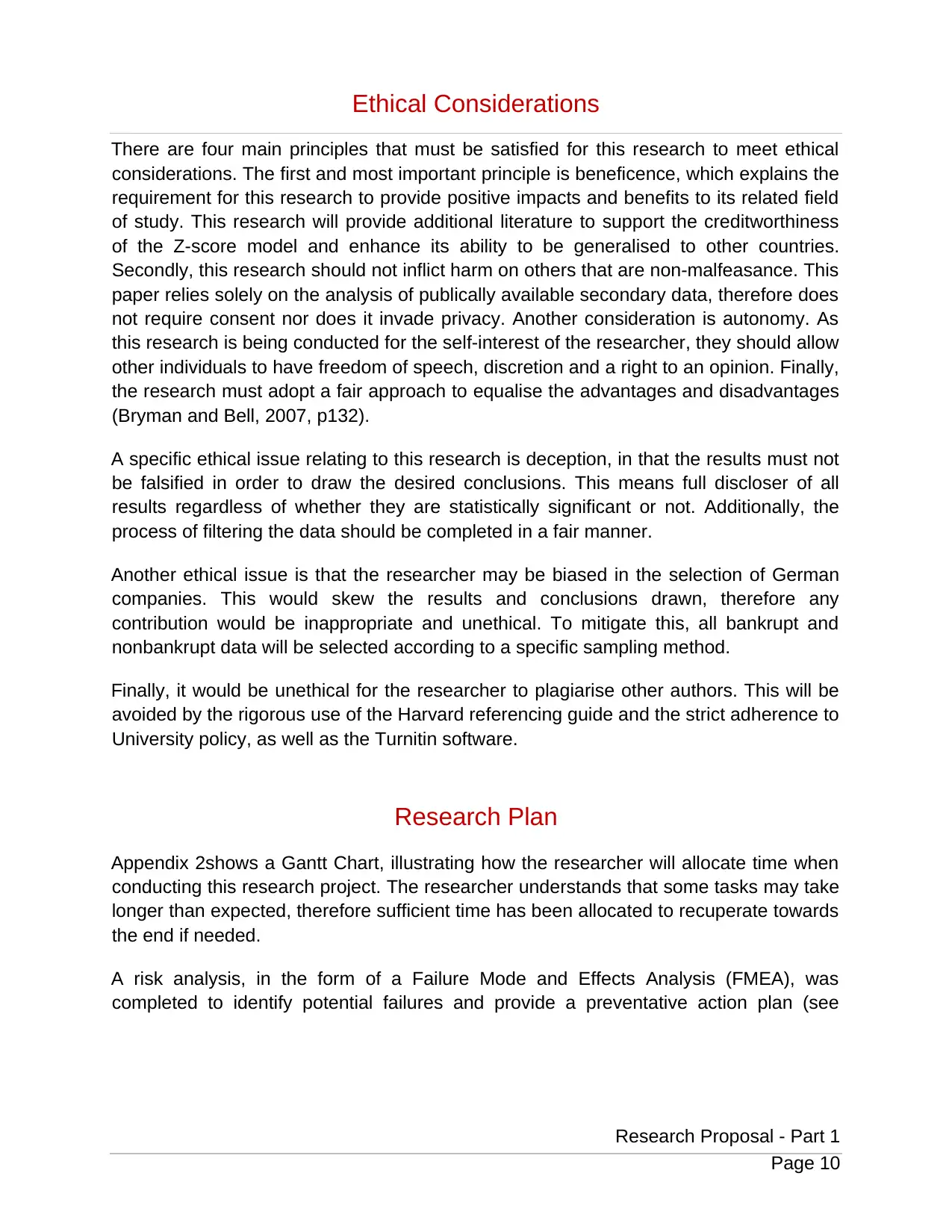
Ethical Considerations
There are four main principles that must be satisfied for this research to meet ethical
considerations. The first and most important principle is beneficence, which explains the
requirement for this research to provide positive impacts and benefits to its related field
of study. This research will provide additional literature to support the creditworthiness
of the Z-score model and enhance its ability to be generalised to other countries.
Secondly, this research should not inflict harm on others that are non-malfeasance. This
paper relies solely on the analysis of publically available secondary data, therefore does
not require consent nor does it invade privacy. Another consideration is autonomy. As
this research is being conducted for the self-interest of the researcher, they should allow
other individuals to have freedom of speech, discretion and a right to an opinion. Finally,
the research must adopt a fair approach to equalise the advantages and disadvantages
(Bryman and Bell, 2007, p132).
A specific ethical issue relating to this research is deception, in that the results must not
be falsified in order to draw the desired conclusions. This means full discloser of all
results regardless of whether they are statistically significant or not. Additionally, the
process of filtering the data should be completed in a fair manner.
Another ethical issue is that the researcher may be biased in the selection of German
companies. This would skew the results and conclusions drawn, therefore any
contribution would be inappropriate and unethical. To mitigate this, all bankrupt and
nonbankrupt data will be selected according to a specific sampling method.
Finally, it would be unethical for the researcher to plagiarise other authors. This will be
avoided by the rigorous use of the Harvard referencing guide and the strict adherence to
University policy, as well as the Turnitin software.
Research Plan
Appendix 2shows a Gantt Chart, illustrating how the researcher will allocate time when
conducting this research project. The researcher understands that some tasks may take
longer than expected, therefore sufficient time has been allocated to recuperate towards
the end if needed.
A risk analysis, in the form of a Failure Mode and Effects Analysis (FMEA), was
completed to identify potential failures and provide a preventative action plan (see
Research Proposal - Part 1
Page 10
There are four main principles that must be satisfied for this research to meet ethical
considerations. The first and most important principle is beneficence, which explains the
requirement for this research to provide positive impacts and benefits to its related field
of study. This research will provide additional literature to support the creditworthiness
of the Z-score model and enhance its ability to be generalised to other countries.
Secondly, this research should not inflict harm on others that are non-malfeasance. This
paper relies solely on the analysis of publically available secondary data, therefore does
not require consent nor does it invade privacy. Another consideration is autonomy. As
this research is being conducted for the self-interest of the researcher, they should allow
other individuals to have freedom of speech, discretion and a right to an opinion. Finally,
the research must adopt a fair approach to equalise the advantages and disadvantages
(Bryman and Bell, 2007, p132).
A specific ethical issue relating to this research is deception, in that the results must not
be falsified in order to draw the desired conclusions. This means full discloser of all
results regardless of whether they are statistically significant or not. Additionally, the
process of filtering the data should be completed in a fair manner.
Another ethical issue is that the researcher may be biased in the selection of German
companies. This would skew the results and conclusions drawn, therefore any
contribution would be inappropriate and unethical. To mitigate this, all bankrupt and
nonbankrupt data will be selected according to a specific sampling method.
Finally, it would be unethical for the researcher to plagiarise other authors. This will be
avoided by the rigorous use of the Harvard referencing guide and the strict adherence to
University policy, as well as the Turnitin software.
Research Plan
Appendix 2shows a Gantt Chart, illustrating how the researcher will allocate time when
conducting this research project. The researcher understands that some tasks may take
longer than expected, therefore sufficient time has been allocated to recuperate towards
the end if needed.
A risk analysis, in the form of a Failure Mode and Effects Analysis (FMEA), was
completed to identify potential failures and provide a preventative action plan (see
Research Proposal - Part 1
Page 10
Paraphrase This Document
Need a fresh take? Get an instant paraphrase of this document with our AI Paraphraser
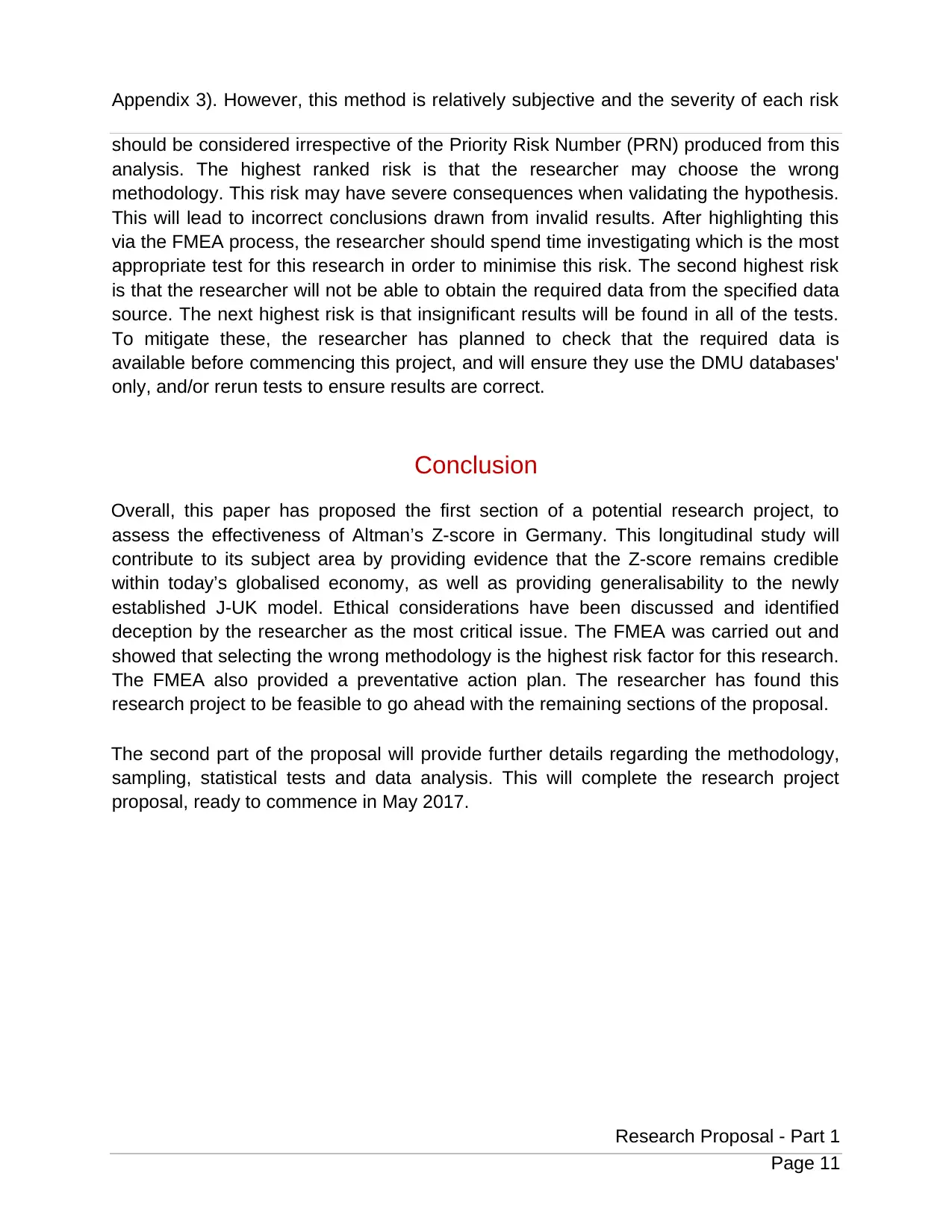
Appendix 3). However, this method is relatively subjective and the severity of each risk
should be considered irrespective of the Priority Risk Number (PRN) produced from this
analysis. The highest ranked risk is that the researcher may choose the wrong
methodology. This risk may have severe consequences when validating the hypothesis.
This will lead to incorrect conclusions drawn from invalid results. After highlighting this
via the FMEA process, the researcher should spend time investigating which is the most
appropriate test for this research in order to minimise this risk. The second highest risk
is that the researcher will not be able to obtain the required data from the specified data
source. The next highest risk is that insignificant results will be found in all of the tests.
To mitigate these, the researcher has planned to check that the required data is
available before commencing this project, and will ensure they use the DMU databases'
only, and/or rerun tests to ensure results are correct.
Conclusion
Overall, this paper has proposed the first section of a potential research project, to
assess the effectiveness of Altman’s Z-score in Germany. This longitudinal study will
contribute to its subject area by providing evidence that the Z-score remains credible
within today’s globalised economy, as well as providing generalisability to the newly
established J-UK model. Ethical considerations have been discussed and identified
deception by the researcher as the most critical issue. The FMEA was carried out and
showed that selecting the wrong methodology is the highest risk factor for this research.
The FMEA also provided a preventative action plan. The researcher has found this
research project to be feasible to go ahead with the remaining sections of the proposal.
The second part of the proposal will provide further details regarding the methodology,
sampling, statistical tests and data analysis. This will complete the research project
proposal, ready to commence in May 2017.
Research Proposal - Part 1
Page 11
should be considered irrespective of the Priority Risk Number (PRN) produced from this
analysis. The highest ranked risk is that the researcher may choose the wrong
methodology. This risk may have severe consequences when validating the hypothesis.
This will lead to incorrect conclusions drawn from invalid results. After highlighting this
via the FMEA process, the researcher should spend time investigating which is the most
appropriate test for this research in order to minimise this risk. The second highest risk
is that the researcher will not be able to obtain the required data from the specified data
source. The next highest risk is that insignificant results will be found in all of the tests.
To mitigate these, the researcher has planned to check that the required data is
available before commencing this project, and will ensure they use the DMU databases'
only, and/or rerun tests to ensure results are correct.
Conclusion
Overall, this paper has proposed the first section of a potential research project, to
assess the effectiveness of Altman’s Z-score in Germany. This longitudinal study will
contribute to its subject area by providing evidence that the Z-score remains credible
within today’s globalised economy, as well as providing generalisability to the newly
established J-UK model. Ethical considerations have been discussed and identified
deception by the researcher as the most critical issue. The FMEA was carried out and
showed that selecting the wrong methodology is the highest risk factor for this research.
The FMEA also provided a preventative action plan. The researcher has found this
research project to be feasible to go ahead with the remaining sections of the proposal.
The second part of the proposal will provide further details regarding the methodology,
sampling, statistical tests and data analysis. This will complete the research project
proposal, ready to commence in May 2017.
Research Proposal - Part 1
Page 11
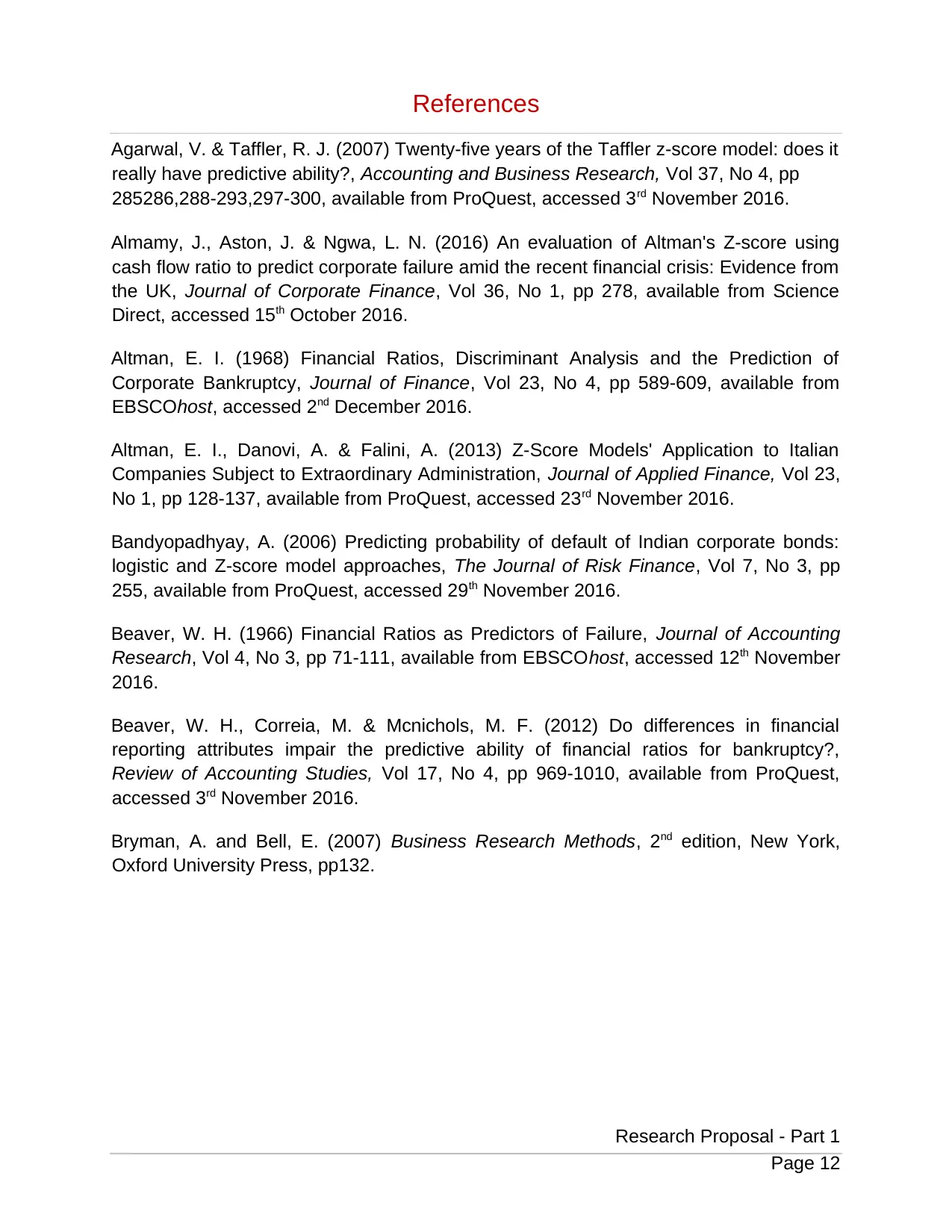
References
Agarwal, V. & Taffler, R. J. (2007) Twenty-five years of the Taffler z-score model: does it
really have predictive ability?, Accounting and Business Research, Vol 37, No 4, pp
285286,288-293,297-300, available from ProQuest, accessed 3rd November 2016.
Almamy, J., Aston, J. & Ngwa, L. N. (2016) An evaluation of Altman's Z-score using
cash flow ratio to predict corporate failure amid the recent financial crisis: Evidence from
the UK, Journal of Corporate Finance, Vol 36, No 1, pp 278, available from Science
Direct, accessed 15th October 2016.
Altman, E. I. (1968) Financial Ratios, Discriminant Analysis and the Prediction of
Corporate Bankruptcy, Journal of Finance, Vol 23, No 4, pp 589-609, available from
EBSCOhost, accessed 2nd December 2016.
Altman, E. I., Danovi, A. & Falini, A. (2013) Z-Score Models' Application to Italian
Companies Subject to Extraordinary Administration, Journal of Applied Finance, Vol 23,
No 1, pp 128-137, available from ProQuest, accessed 23rd November 2016.
Bandyopadhyay, A. (2006) Predicting probability of default of Indian corporate bonds:
logistic and Z-score model approaches, The Journal of Risk Finance, Vol 7, No 3, pp
255, available from ProQuest, accessed 29th November 2016.
Beaver, W. H. (1966) Financial Ratios as Predictors of Failure, Journal of Accounting
Research, Vol 4, No 3, pp 71-111, available from EBSCOhost, accessed 12th November
2016.
Beaver, W. H., Correia, M. & Mcnichols, M. F. (2012) Do differences in financial
reporting attributes impair the predictive ability of financial ratios for bankruptcy?,
Review of Accounting Studies, Vol 17, No 4, pp 969-1010, available from ProQuest,
accessed 3rd November 2016.
Bryman, A. and Bell, E. (2007) Business Research Methods, 2nd edition, New York,
Oxford University Press, pp132.
Research Proposal - Part 1
Page 12
Agarwal, V. & Taffler, R. J. (2007) Twenty-five years of the Taffler z-score model: does it
really have predictive ability?, Accounting and Business Research, Vol 37, No 4, pp
285286,288-293,297-300, available from ProQuest, accessed 3rd November 2016.
Almamy, J., Aston, J. & Ngwa, L. N. (2016) An evaluation of Altman's Z-score using
cash flow ratio to predict corporate failure amid the recent financial crisis: Evidence from
the UK, Journal of Corporate Finance, Vol 36, No 1, pp 278, available from Science
Direct, accessed 15th October 2016.
Altman, E. I. (1968) Financial Ratios, Discriminant Analysis and the Prediction of
Corporate Bankruptcy, Journal of Finance, Vol 23, No 4, pp 589-609, available from
EBSCOhost, accessed 2nd December 2016.
Altman, E. I., Danovi, A. & Falini, A. (2013) Z-Score Models' Application to Italian
Companies Subject to Extraordinary Administration, Journal of Applied Finance, Vol 23,
No 1, pp 128-137, available from ProQuest, accessed 23rd November 2016.
Bandyopadhyay, A. (2006) Predicting probability of default of Indian corporate bonds:
logistic and Z-score model approaches, The Journal of Risk Finance, Vol 7, No 3, pp
255, available from ProQuest, accessed 29th November 2016.
Beaver, W. H. (1966) Financial Ratios as Predictors of Failure, Journal of Accounting
Research, Vol 4, No 3, pp 71-111, available from EBSCOhost, accessed 12th November
2016.
Beaver, W. H., Correia, M. & Mcnichols, M. F. (2012) Do differences in financial
reporting attributes impair the predictive ability of financial ratios for bankruptcy?,
Review of Accounting Studies, Vol 17, No 4, pp 969-1010, available from ProQuest,
accessed 3rd November 2016.
Bryman, A. and Bell, E. (2007) Business Research Methods, 2nd edition, New York,
Oxford University Press, pp132.
Research Proposal - Part 1
Page 12
You're viewing a preview
Unlock full access by subscribing today!

Choong, N. K. & McLeod, R., Jr. (1999) Expert, linear models, and nonlinear models of
expert decision making in bankruptcy prediction: A lens model analysis, Journal of
Management Information Systems, Vol 16, No 1, pp 189-206, available from ProQuest,
accessed 23rd November 2016.
Grice, J. S. & Dugan, M. T. (2001) The Limitations of Bankruptcy Prediction Models:
Some Cautions for the Researcher, Review of Quantitative Finance and Accounting, Vol
17, No 2, pp 151, available from ProQuest, accessed 3rd November 2016.
Grice, J. S. & Ingram, R. W. (2001) Tests of the generalizability of Altman's bankruptcy
prediction model, Journal of Business Research, Vol 54, No 1, pp 53-61, available from
ScienceDirect, accessed 3rd November 2016.
Hillegeist, S. A., Keating, E. K., Cram, D. P. & Lundstedt, K. G. (2004) Assessing the
Probability of Bankruptcy, Review of Accounting Studies, Vol 9, No 1, pp 5-34, available
from ProQuest, accessed 3rd November 2016.
Katz, S., Lilien, S. & Nelson, B. (1985) Stock Market Behavior Around Bankruptcy Model
Distress and Recovery Predictions, Financial Analysts Journal, Vol 41, No 1, pp 70,
available from EBSCOhost, accessed 3rd November 2016.
Kwak, W., Shi, Y. & Kou, G. (2012) Bankruptcy prediction for Korean firms after the 1997
financial crisis: using a multiple criteria linear programming data mining approach,
Review of Quantitative Finance and Accounting, Vol 38, No 4, pp 441-453, available
from ProQuest, accessed 3rd November 2016.
Lawrence, E. & Bear, R. (1986) Corporate Bankruptcy Prediction and the Impact of
Leases, Journal of Business Finance & Accounting, Vol 13, No 4, pp 571-585, available
from EBSCOhost, accessed 23rd November 2016.
Mossman, C. E., Bell, G. G., L, M. S. & Turtle, H. (1998) An empirical comparision of
bankruptcy models, The Financial Review, Vol 33, No 2, pp 35-53, available from
ProQuest, accessed 23rd November 2016.
Ohlson, J. A. (1980) Financial Ratios and the Probabilistic Prediction of Bankruptcy,
Journal of Accounting Research, Vol 18, No 1, pp 109-131, available from EBSCOhost,
accessed 3rd December 2016.
Saunders, M., Lewis, P. and Thornhill, A. (2016) Research methods for business
students, 7th ed, Harlow, Pearson Education Ltd, pp200, 298.
Research Proposal - Part 1
Page 13
expert decision making in bankruptcy prediction: A lens model analysis, Journal of
Management Information Systems, Vol 16, No 1, pp 189-206, available from ProQuest,
accessed 23rd November 2016.
Grice, J. S. & Dugan, M. T. (2001) The Limitations of Bankruptcy Prediction Models:
Some Cautions for the Researcher, Review of Quantitative Finance and Accounting, Vol
17, No 2, pp 151, available from ProQuest, accessed 3rd November 2016.
Grice, J. S. & Ingram, R. W. (2001) Tests of the generalizability of Altman's bankruptcy
prediction model, Journal of Business Research, Vol 54, No 1, pp 53-61, available from
ScienceDirect, accessed 3rd November 2016.
Hillegeist, S. A., Keating, E. K., Cram, D. P. & Lundstedt, K. G. (2004) Assessing the
Probability of Bankruptcy, Review of Accounting Studies, Vol 9, No 1, pp 5-34, available
from ProQuest, accessed 3rd November 2016.
Katz, S., Lilien, S. & Nelson, B. (1985) Stock Market Behavior Around Bankruptcy Model
Distress and Recovery Predictions, Financial Analysts Journal, Vol 41, No 1, pp 70,
available from EBSCOhost, accessed 3rd November 2016.
Kwak, W., Shi, Y. & Kou, G. (2012) Bankruptcy prediction for Korean firms after the 1997
financial crisis: using a multiple criteria linear programming data mining approach,
Review of Quantitative Finance and Accounting, Vol 38, No 4, pp 441-453, available
from ProQuest, accessed 3rd November 2016.
Lawrence, E. & Bear, R. (1986) Corporate Bankruptcy Prediction and the Impact of
Leases, Journal of Business Finance & Accounting, Vol 13, No 4, pp 571-585, available
from EBSCOhost, accessed 23rd November 2016.
Mossman, C. E., Bell, G. G., L, M. S. & Turtle, H. (1998) An empirical comparision of
bankruptcy models, The Financial Review, Vol 33, No 2, pp 35-53, available from
ProQuest, accessed 23rd November 2016.
Ohlson, J. A. (1980) Financial Ratios and the Probabilistic Prediction of Bankruptcy,
Journal of Accounting Research, Vol 18, No 1, pp 109-131, available from EBSCOhost,
accessed 3rd December 2016.
Saunders, M., Lewis, P. and Thornhill, A. (2016) Research methods for business
students, 7th ed, Harlow, Pearson Education Ltd, pp200, 298.
Research Proposal - Part 1
Page 13
Paraphrase This Document
Need a fresh take? Get an instant paraphrase of this document with our AI Paraphraser

Wang, Y. & Campbell, M. (2010) Business Failure Prediction for Publicly Listed
Companies in China, Journal of Business and Management, Vol 16, No 1, pp 75-88,
available from ProQuest, accessed 23rd November 2016.
Zmijewski, M. E. (1984) Methodological Issues Related to the Estimation of Financial
Distress Prediction Models, Journal of Accounting Research, Vol 22, No 1, pp 59-82,
available from EBSCOhost, accessed 21st November 2016.
Research Proposal - Part 1
Page 14
Companies in China, Journal of Business and Management, Vol 16, No 1, pp 75-88,
available from ProQuest, accessed 23rd November 2016.
Zmijewski, M. E. (1984) Methodological Issues Related to the Estimation of Financial
Distress Prediction Models, Journal of Accounting Research, Vol 22, No 1, pp 59-82,
available from EBSCOhost, accessed 21st November 2016.
Research Proposal - Part 1
Page 14

Bibliography
Altman, E. I. and Hotchkiss, E. (2006) Corporate Financial Distress and Bankruptcy, 3rd
ed, New Jersey, John Wiley & Sons, Inc., pp93-121, 183-219, 281-307.
Boda, M. & Úradnícek, V. (2016) The portability of altman's Z-score model to predicting
corporate financial distress of Slovak companies, Technological and Economic
Development of Economy, Vol 22, No 4, pp 532-553, available from ProQuest, accessed
28th November 2016.
Bryman, A. and Bell, E. (2007) Business Research Methods, 2nd edition, New York,
Oxford University Press, pp132-145.
Charalambous, C., Charitou, A. & Kaourou, F. (2000) Comparative analysis of artificial
neural network models: Application in bankruptcy prediction, Annals of Operations
Research, Vol 99, No 1, pp 403-425, available from ProQuest, accessed 23rd November
2016.
Chava, S. & Jarrow, R. A. (2004) Bankruptcy Prediction with Industry Effects, Review of
Finance, Vol 8, No 4, pp 537-567, available from ProQuest, accessed 23rd November
2016.
D'Aveni, R. A. (1989) Dependability and Organizational Bankruptcy: An Application of
Agency and Prospect Theory, Management Science, Vol 35, No 9, pp 1120, available
from ProQuest, accessed 23rd November 2016.
du Jardin, P. (2015) Bankruptcy prediction using terminal failure processes, European
Journal of Operational Research, Vol 242, No 1, pp 286, available from ProQuest,
accessed 23rd November 2016.
El Hennawy, R, & Morris, R (1983) The Significance of Base Year in Developing Failure
Prediction Models, Journal of Business Finance & Accounting, Vol 10, No 2, pp 209-223,
available from EBSCOhost, accessed 23rd November 2016.
Graham, J., Lemmon, M. & Schallheim, J. (1998) Debt, Leases, Taxes, and the
Endogeneity of Corporate Tax Status, Journal of Finance, Vol 53, No 1, pp 131-162,
available from EBSCOhost, accessed 23rd November 2016.
Research Proposal - Part 1
Page 15
Altman, E. I. and Hotchkiss, E. (2006) Corporate Financial Distress and Bankruptcy, 3rd
ed, New Jersey, John Wiley & Sons, Inc., pp93-121, 183-219, 281-307.
Boda, M. & Úradnícek, V. (2016) The portability of altman's Z-score model to predicting
corporate financial distress of Slovak companies, Technological and Economic
Development of Economy, Vol 22, No 4, pp 532-553, available from ProQuest, accessed
28th November 2016.
Bryman, A. and Bell, E. (2007) Business Research Methods, 2nd edition, New York,
Oxford University Press, pp132-145.
Charalambous, C., Charitou, A. & Kaourou, F. (2000) Comparative analysis of artificial
neural network models: Application in bankruptcy prediction, Annals of Operations
Research, Vol 99, No 1, pp 403-425, available from ProQuest, accessed 23rd November
2016.
Chava, S. & Jarrow, R. A. (2004) Bankruptcy Prediction with Industry Effects, Review of
Finance, Vol 8, No 4, pp 537-567, available from ProQuest, accessed 23rd November
2016.
D'Aveni, R. A. (1989) Dependability and Organizational Bankruptcy: An Application of
Agency and Prospect Theory, Management Science, Vol 35, No 9, pp 1120, available
from ProQuest, accessed 23rd November 2016.
du Jardin, P. (2015) Bankruptcy prediction using terminal failure processes, European
Journal of Operational Research, Vol 242, No 1, pp 286, available from ProQuest,
accessed 23rd November 2016.
El Hennawy, R, & Morris, R (1983) The Significance of Base Year in Developing Failure
Prediction Models, Journal of Business Finance & Accounting, Vol 10, No 2, pp 209-223,
available from EBSCOhost, accessed 23rd November 2016.
Graham, J., Lemmon, M. & Schallheim, J. (1998) Debt, Leases, Taxes, and the
Endogeneity of Corporate Tax Status, Journal of Finance, Vol 53, No 1, pp 131-162,
available from EBSCOhost, accessed 23rd November 2016.
Research Proposal - Part 1
Page 15
You're viewing a preview
Unlock full access by subscribing today!
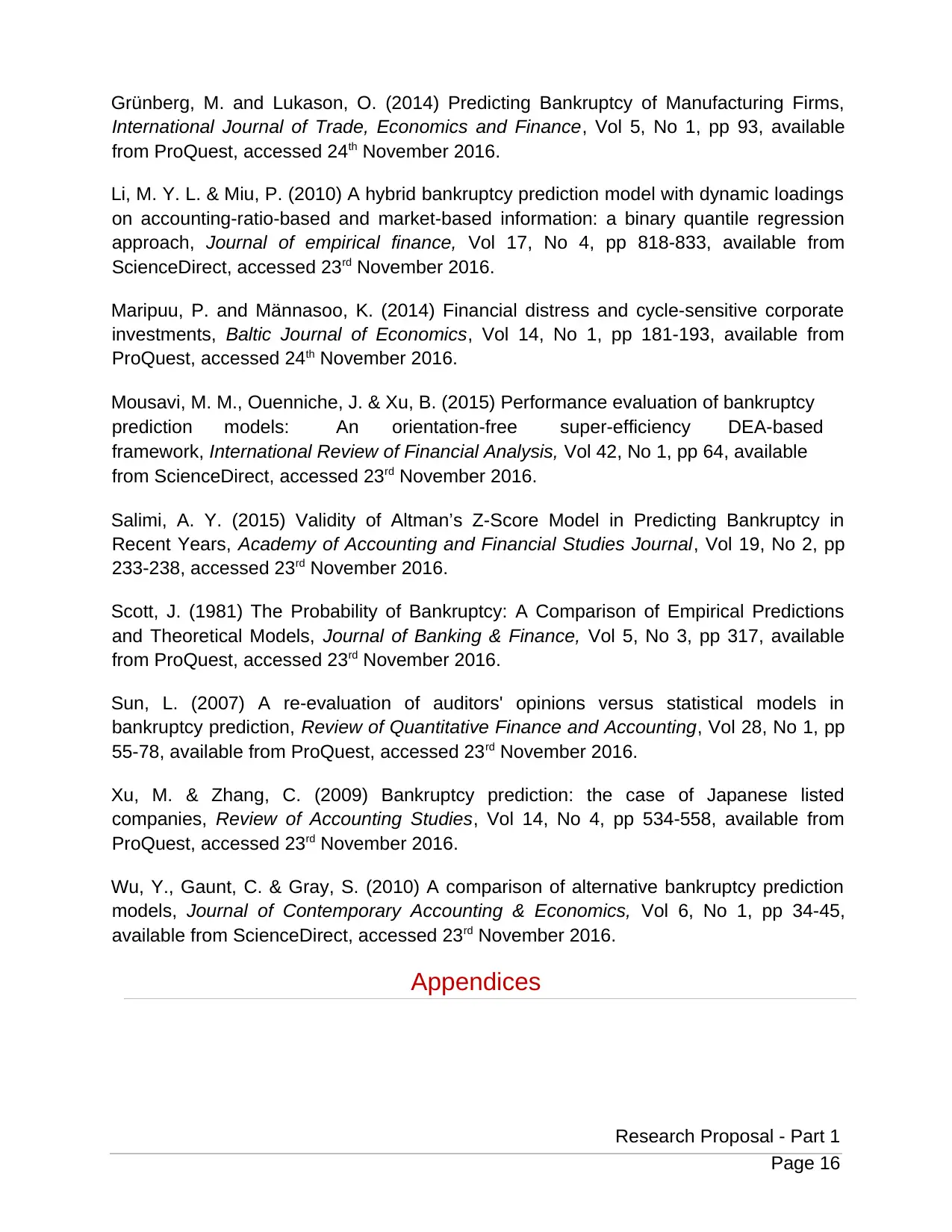
Grünberg, M. and Lukason, O. (2014) Predicting Bankruptcy of Manufacturing Firms,
International Journal of Trade, Economics and Finance, Vol 5, No 1, pp 93, available
from ProQuest, accessed 24th November 2016.
Li, M. Y. L. & Miu, P. (2010) A hybrid bankruptcy prediction model with dynamic loadings
on accounting-ratio-based and market-based information: a binary quantile regression
approach, Journal of empirical finance, Vol 17, No 4, pp 818-833, available from
ScienceDirect, accessed 23rd November 2016.
Maripuu, P. and Männasoo, K. (2014) Financial distress and cycle-sensitive corporate
investments, Baltic Journal of Economics, Vol 14, No 1, pp 181-193, available from
ProQuest, accessed 24th November 2016.
Mousavi, M. M., Ouenniche, J. & Xu, B. (2015) Performance evaluation of bankruptcy
prediction models: An orientation-free super-efficiency DEA-based
framework, International Review of Financial Analysis, Vol 42, No 1, pp 64, available
from ScienceDirect, accessed 23rd November 2016.
Salimi, A. Y. (2015) Validity of Altman’s Z-Score Model in Predicting Bankruptcy in
Recent Years, Academy of Accounting and Financial Studies Journal, Vol 19, No 2, pp
233-238, accessed 23rd November 2016.
Scott, J. (1981) The Probability of Bankruptcy: A Comparison of Empirical Predictions
and Theoretical Models, Journal of Banking & Finance, Vol 5, No 3, pp 317, available
from ProQuest, accessed 23rd November 2016.
Sun, L. (2007) A re-evaluation of auditors' opinions versus statistical models in
bankruptcy prediction, Review of Quantitative Finance and Accounting, Vol 28, No 1, pp
55-78, available from ProQuest, accessed 23rd November 2016.
Xu, M. & Zhang, C. (2009) Bankruptcy prediction: the case of Japanese listed
companies, Review of Accounting Studies, Vol 14, No 4, pp 534-558, available from
ProQuest, accessed 23rd November 2016.
Wu, Y., Gaunt, C. & Gray, S. (2010) A comparison of alternative bankruptcy prediction
models, Journal of Contemporary Accounting & Economics, Vol 6, No 1, pp 34-45,
available from ScienceDirect, accessed 23rd November 2016.
Appendices
Research Proposal - Part 1
Page 16
International Journal of Trade, Economics and Finance, Vol 5, No 1, pp 93, available
from ProQuest, accessed 24th November 2016.
Li, M. Y. L. & Miu, P. (2010) A hybrid bankruptcy prediction model with dynamic loadings
on accounting-ratio-based and market-based information: a binary quantile regression
approach, Journal of empirical finance, Vol 17, No 4, pp 818-833, available from
ScienceDirect, accessed 23rd November 2016.
Maripuu, P. and Männasoo, K. (2014) Financial distress and cycle-sensitive corporate
investments, Baltic Journal of Economics, Vol 14, No 1, pp 181-193, available from
ProQuest, accessed 24th November 2016.
Mousavi, M. M., Ouenniche, J. & Xu, B. (2015) Performance evaluation of bankruptcy
prediction models: An orientation-free super-efficiency DEA-based
framework, International Review of Financial Analysis, Vol 42, No 1, pp 64, available
from ScienceDirect, accessed 23rd November 2016.
Salimi, A. Y. (2015) Validity of Altman’s Z-Score Model in Predicting Bankruptcy in
Recent Years, Academy of Accounting and Financial Studies Journal, Vol 19, No 2, pp
233-238, accessed 23rd November 2016.
Scott, J. (1981) The Probability of Bankruptcy: A Comparison of Empirical Predictions
and Theoretical Models, Journal of Banking & Finance, Vol 5, No 3, pp 317, available
from ProQuest, accessed 23rd November 2016.
Sun, L. (2007) A re-evaluation of auditors' opinions versus statistical models in
bankruptcy prediction, Review of Quantitative Finance and Accounting, Vol 28, No 1, pp
55-78, available from ProQuest, accessed 23rd November 2016.
Xu, M. & Zhang, C. (2009) Bankruptcy prediction: the case of Japanese listed
companies, Review of Accounting Studies, Vol 14, No 4, pp 534-558, available from
ProQuest, accessed 23rd November 2016.
Wu, Y., Gaunt, C. & Gray, S. (2010) A comparison of alternative bankruptcy prediction
models, Journal of Contemporary Accounting & Economics, Vol 6, No 1, pp 34-45,
available from ScienceDirect, accessed 23rd November 2016.
Appendices
Research Proposal - Part 1
Page 16
Paraphrase This Document
Need a fresh take? Get an instant paraphrase of this document with our AI Paraphraser
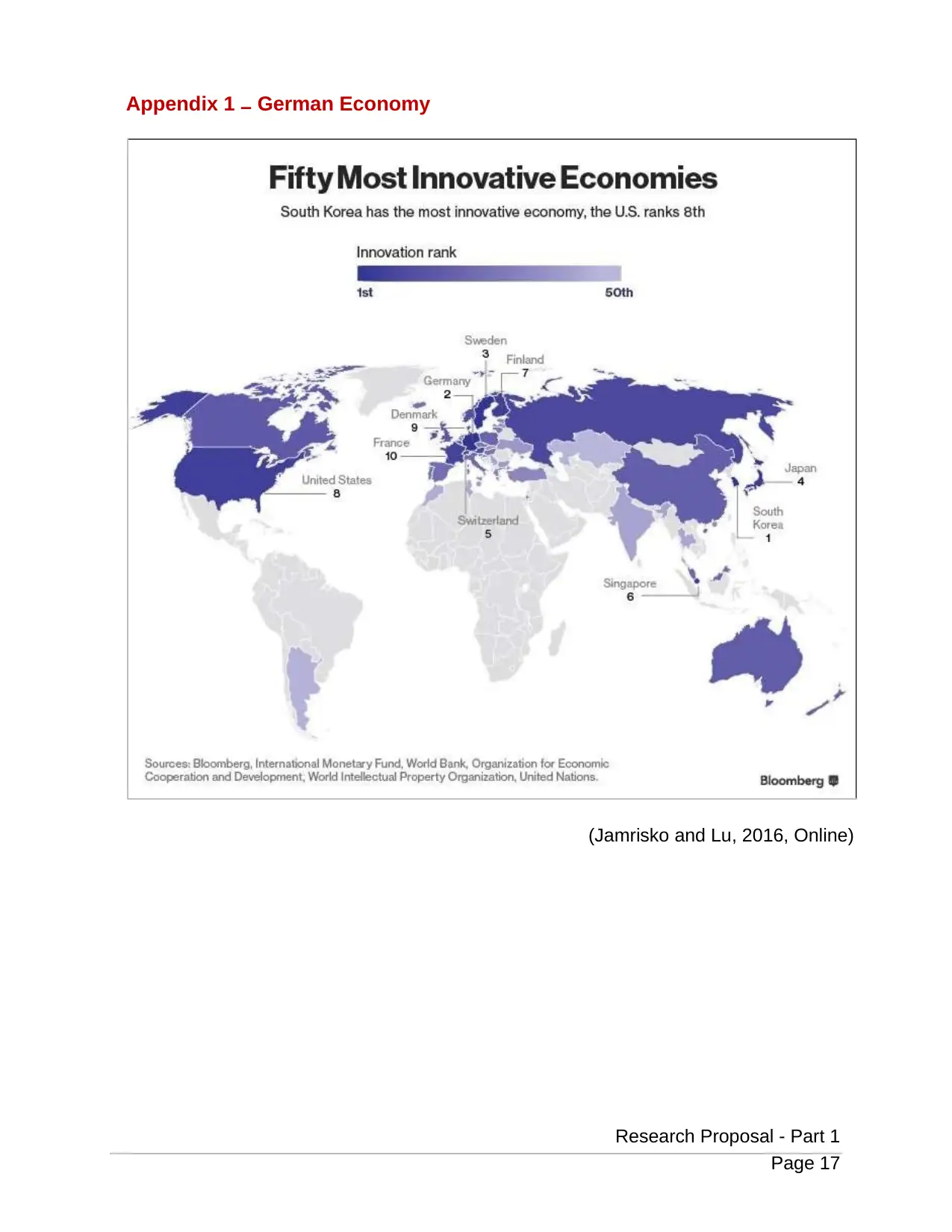
Appendix 1 – German Economy
(Jamrisko and Lu, 2016, Online)
Research Proposal - Part 1
Page 17
(Jamrisko and Lu, 2016, Online)
Research Proposal - Part 1
Page 17
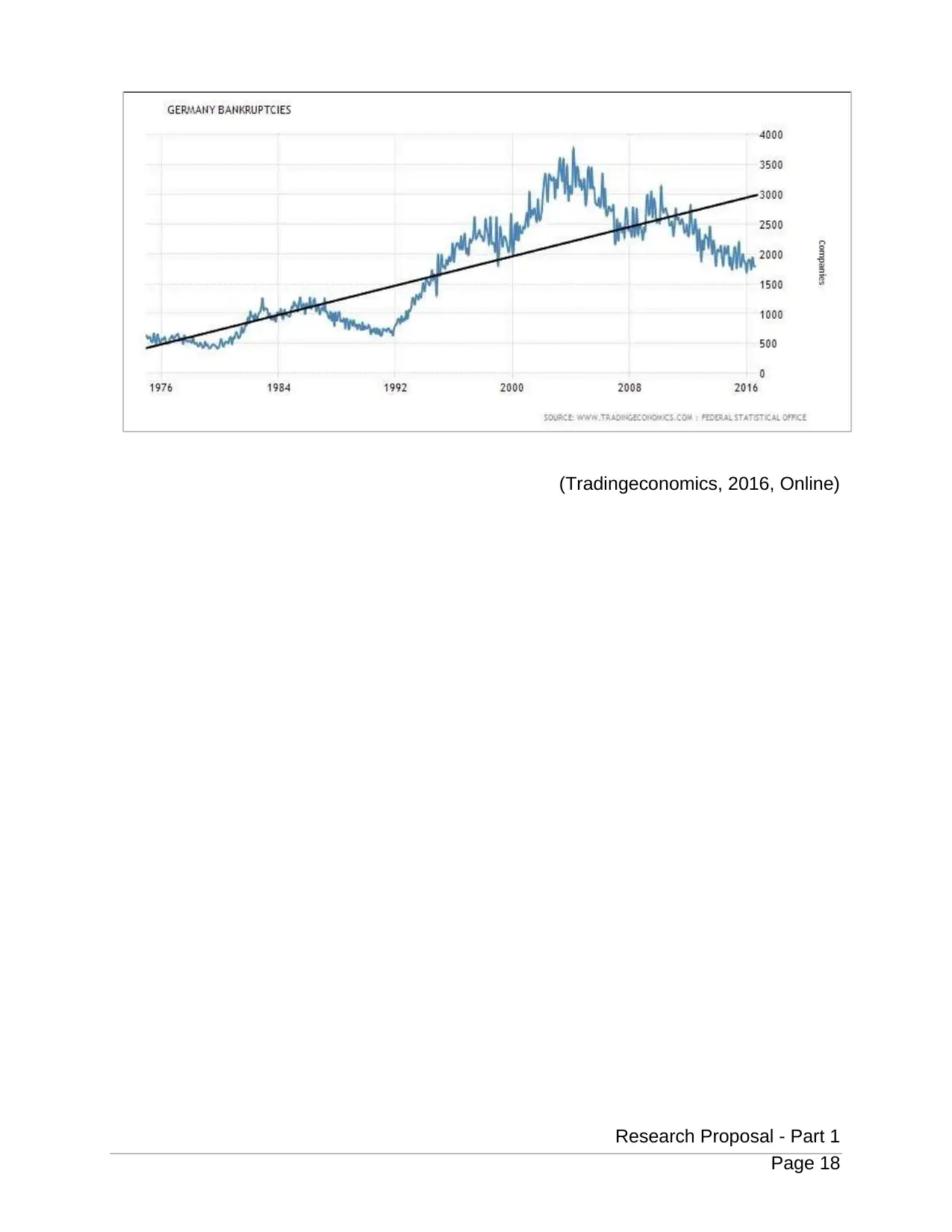
(Tradingeconomics, 2016, Online)
Research Proposal - Part 1
Page 18
Research Proposal - Part 1
Page 18
You're viewing a preview
Unlock full access by subscribing today!
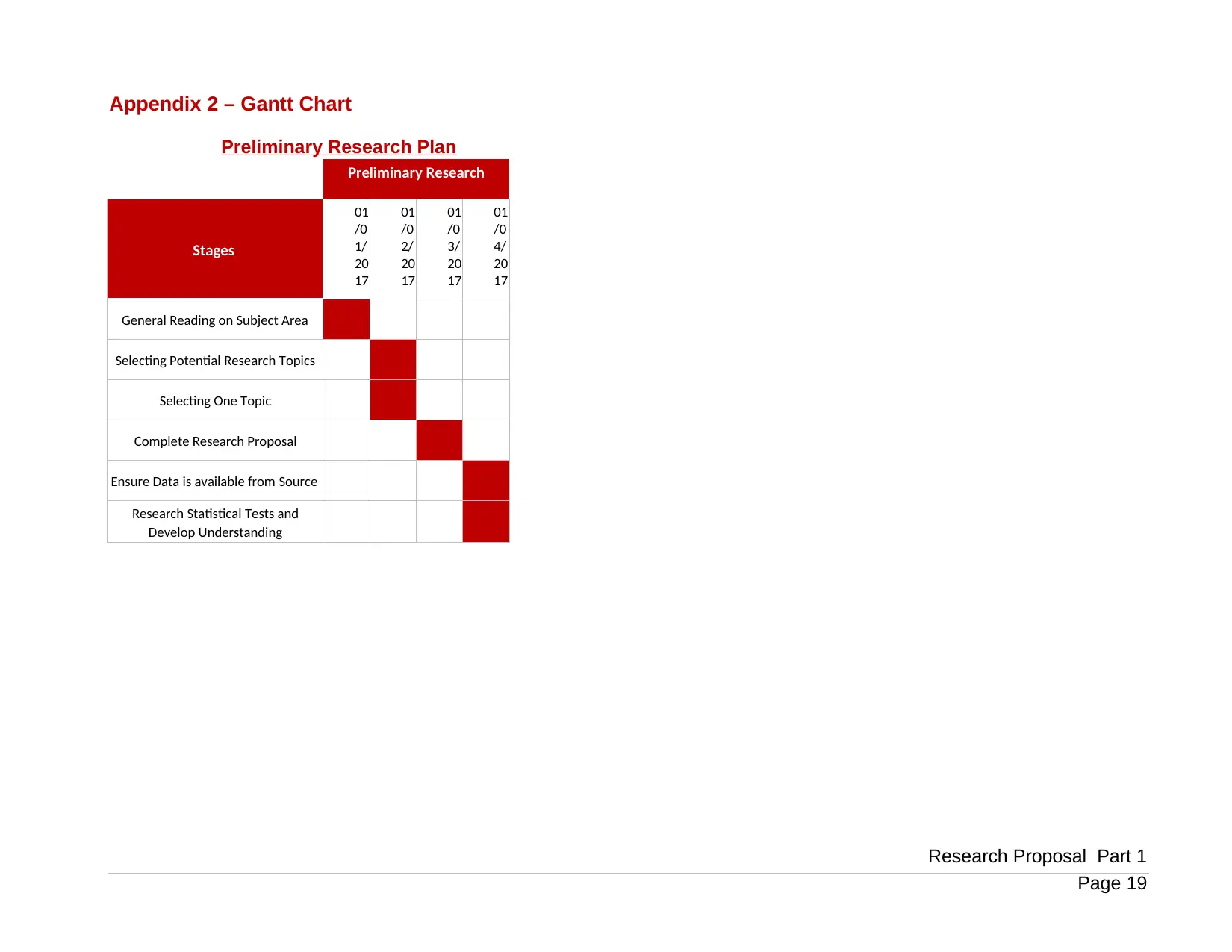
01
/0
1/
20
17
01
/0
2/
20
17
01
/0
3/
20
17
01
/0
4/
20
17
Appendix 2 – Gantt Chart
Preliminary Research Plan
Preliminary Research
Stages
General Reading on Subject Area
Selecting Potential Research Topics
Selecting One Topic
Complete Research Proposal
Ensure Data is available from Source
Research Statistical Tests and
Develop Understanding
Research Proposal Part 1
Page 19
/0
1/
20
17
01
/0
2/
20
17
01
/0
3/
20
17
01
/0
4/
20
17
Appendix 2 – Gantt Chart
Preliminary Research Plan
Preliminary Research
Stages
General Reading on Subject Area
Selecting Potential Research Topics
Selecting One Topic
Complete Research Proposal
Ensure Data is available from Source
Research Statistical Tests and
Develop Understanding
Research Proposal Part 1
Page 19
Paraphrase This Document
Need a fresh take? Get an instant paraphrase of this document with our AI Paraphraser
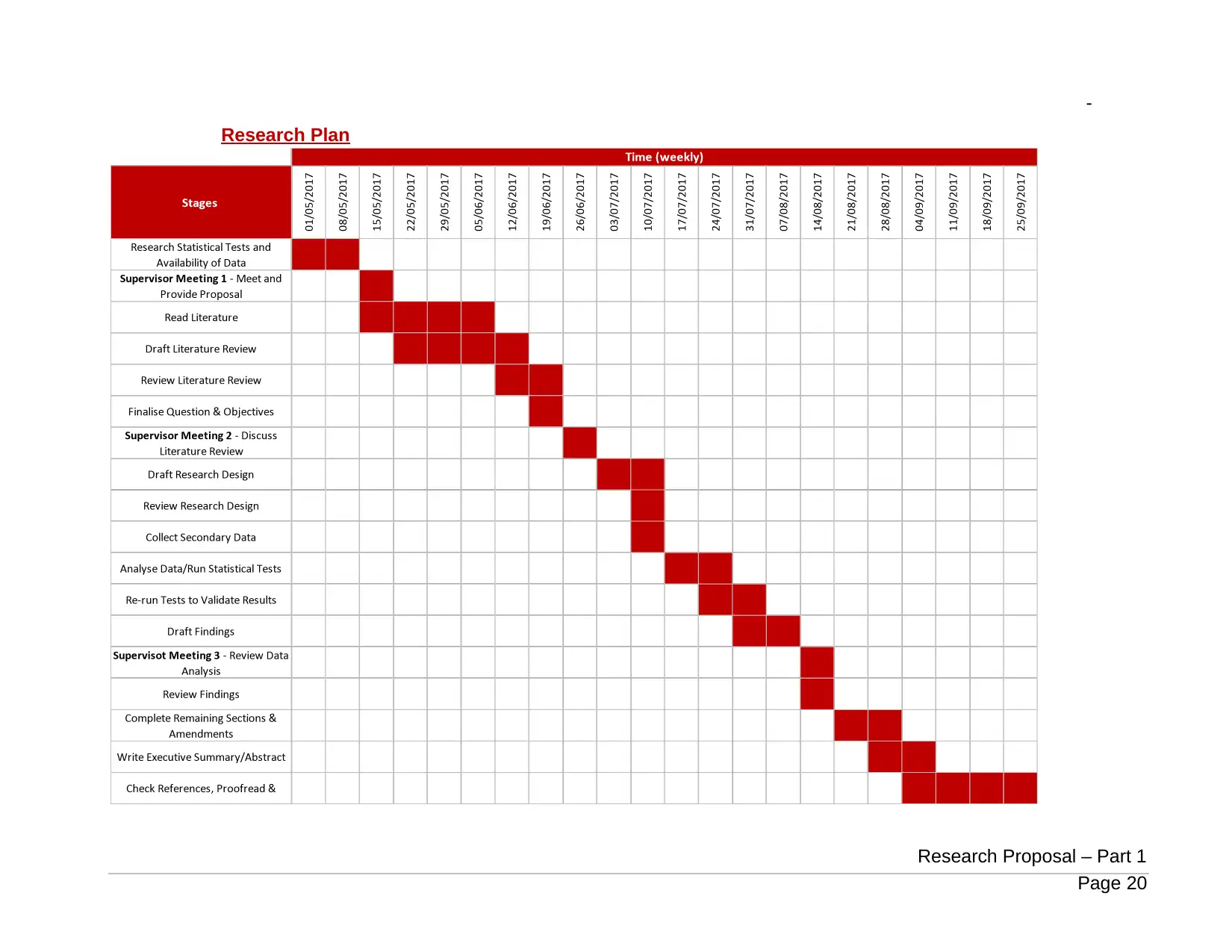
-
Research Plan
Research Proposal – Part 1
Page 20
Research Plan
Research Proposal – Part 1
Page 20

-
Appendix 3 – FMEA Risk Analysis
Rating Scale
Rating Scale for
Severity
Number Description
1-2 Minor
3-4 Low
5-6 Moderate
7-8 High
9-10 Severe
Rating Scale for Likelihood
Number Description
1 Completely Unlikely
2-3 Unlikely
4-5 Somewhat Unlikely
6-7 Likely
8-9 Certain
10 Extremely Certain
Rating Scale for
Detection
Number Description
1-2 Simple
3-4 Moderate
5-6 Hard
7-8 Difficult
9-10 Impossible
Rating Scale for
Effectiveness of Action Plan
Number Description
1 Complete Effect
2-3 Excellent/Great
4-5 Good
6-7 Satisfactory
8-9 Poor/Minimal
10 No Effect
Research Proposal Part 1
Page 21
Appendix 3 – FMEA Risk Analysis
Rating Scale
Rating Scale for
Severity
Number Description
1-2 Minor
3-4 Low
5-6 Moderate
7-8 High
9-10 Severe
Rating Scale for Likelihood
Number Description
1 Completely Unlikely
2-3 Unlikely
4-5 Somewhat Unlikely
6-7 Likely
8-9 Certain
10 Extremely Certain
Rating Scale for
Detection
Number Description
1-2 Simple
3-4 Moderate
5-6 Hard
7-8 Difficult
9-10 Impossible
Rating Scale for
Effectiveness of Action Plan
Number Description
1 Complete Effect
2-3 Excellent/Great
4-5 Good
6-7 Satisfactory
8-9 Poor/Minimal
10 No Effect
Research Proposal Part 1
Page 21
You're viewing a preview
Unlock full access by subscribing today!

FMEA Analysis
Research Proposal – Part 1
Page 22
Research Proposal – Part 1
Page 22
Paraphrase This Document
Need a fresh take? Get an instant paraphrase of this document with our AI Paraphraser
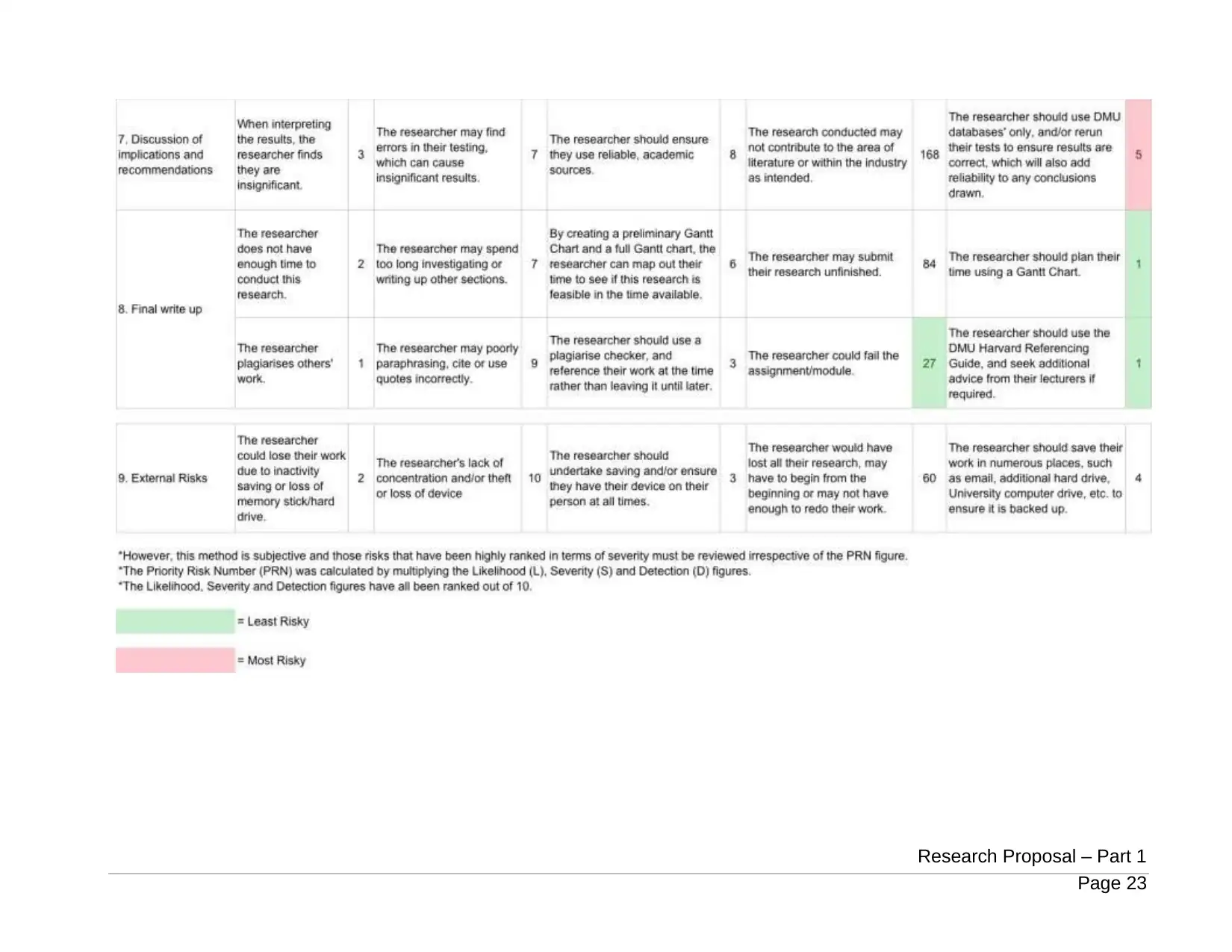
Research Proposal – Part 1
Page 23
Page 23
1 out of 23
Related Documents
Your All-in-One AI-Powered Toolkit for Academic Success.
+13062052269
info@desklib.com
Available 24*7 on WhatsApp / Email
![[object Object]](/_next/static/media/star-bottom.7253800d.svg)
Unlock your academic potential
© 2024 | Zucol Services PVT LTD | All rights reserved.





